Abstract
Defined media permitting extensive growth of representative pink radio-resistant tetracocci (Micrococcus radiodurans, Micrococcus roseus, and Micrococcus radiophilus) and two controls (an ultraviolet-sensitive mutant of M. radiodurans and Micrococcus luteus) are described. Availability of Fe (especially Fe3+) proved essential for good growth, as evidenced by (i) favorable effects of hydroxamic acids, e.g., salicylhydroxamic acid, and (ii) the growth promotion by hemin when joined with elevated concentrations of Fe. Cobalamin (B12) and methionine were interchangeable as an absolute requirement for methionine not affected by B12. M. luteus required neither. Pink radio-resistant micrococci may form a coherent group. Some divergences among them might be attributable to the method for isolating them, which for ordinary bacteria would be mutagenic to the point of total lethality. The ecology of these tetracocci vis-à-vis other pink-red radio-resistant organisms is discussed in relation to a question: can these bacteria be isolated without dependence on radiation as the cardinal selective factor?
Full text
PDF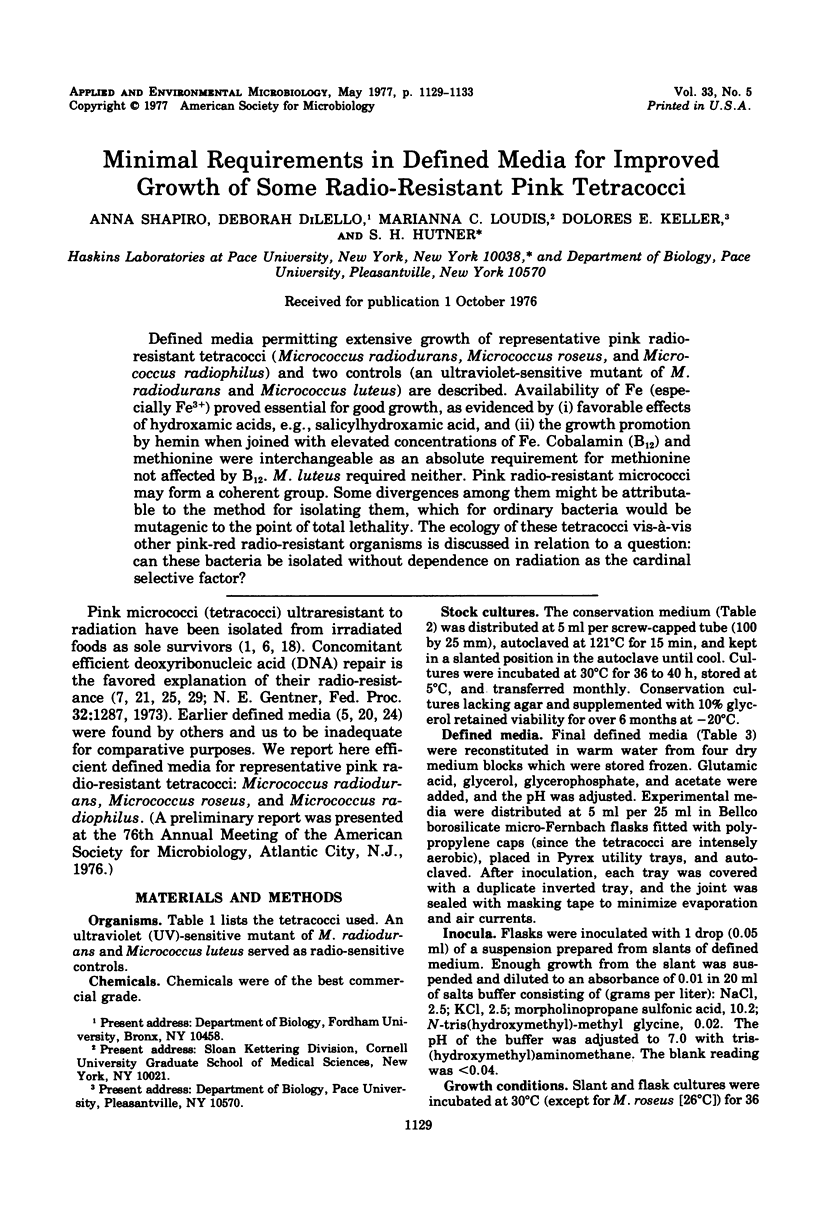
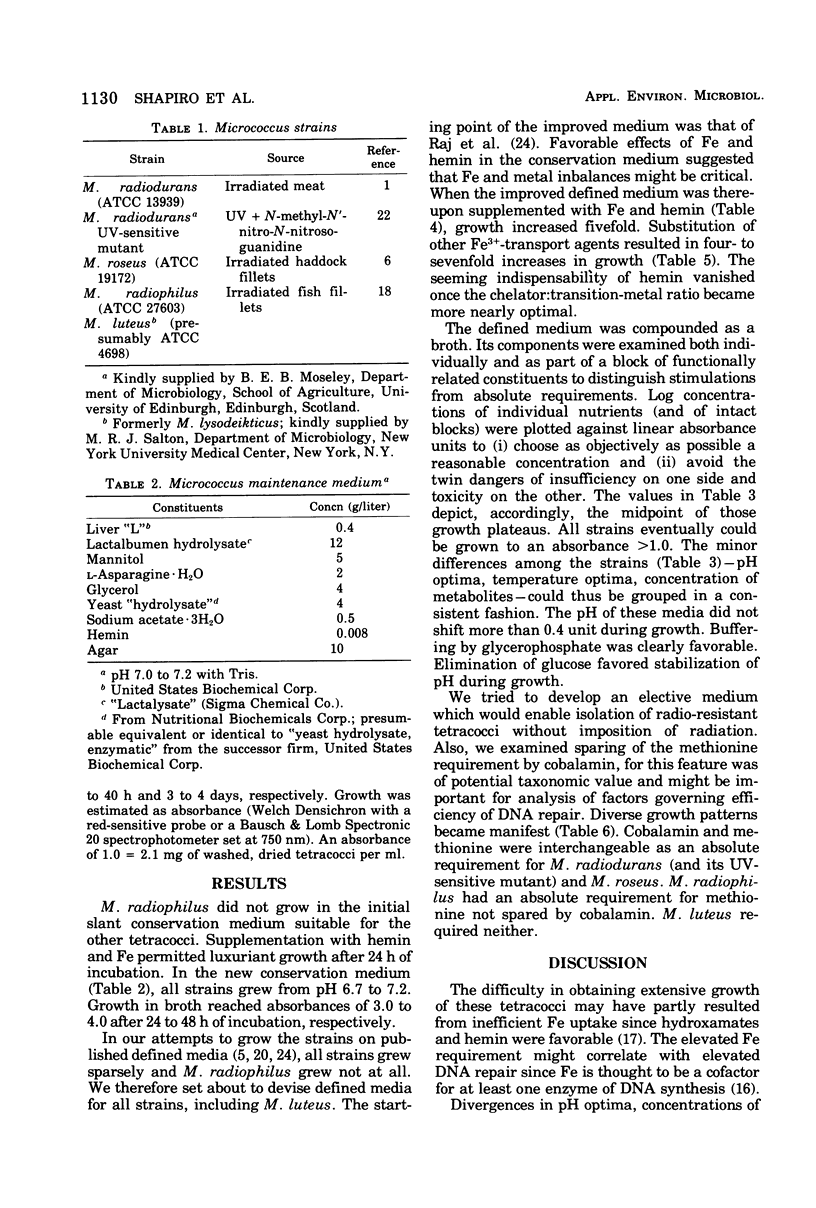
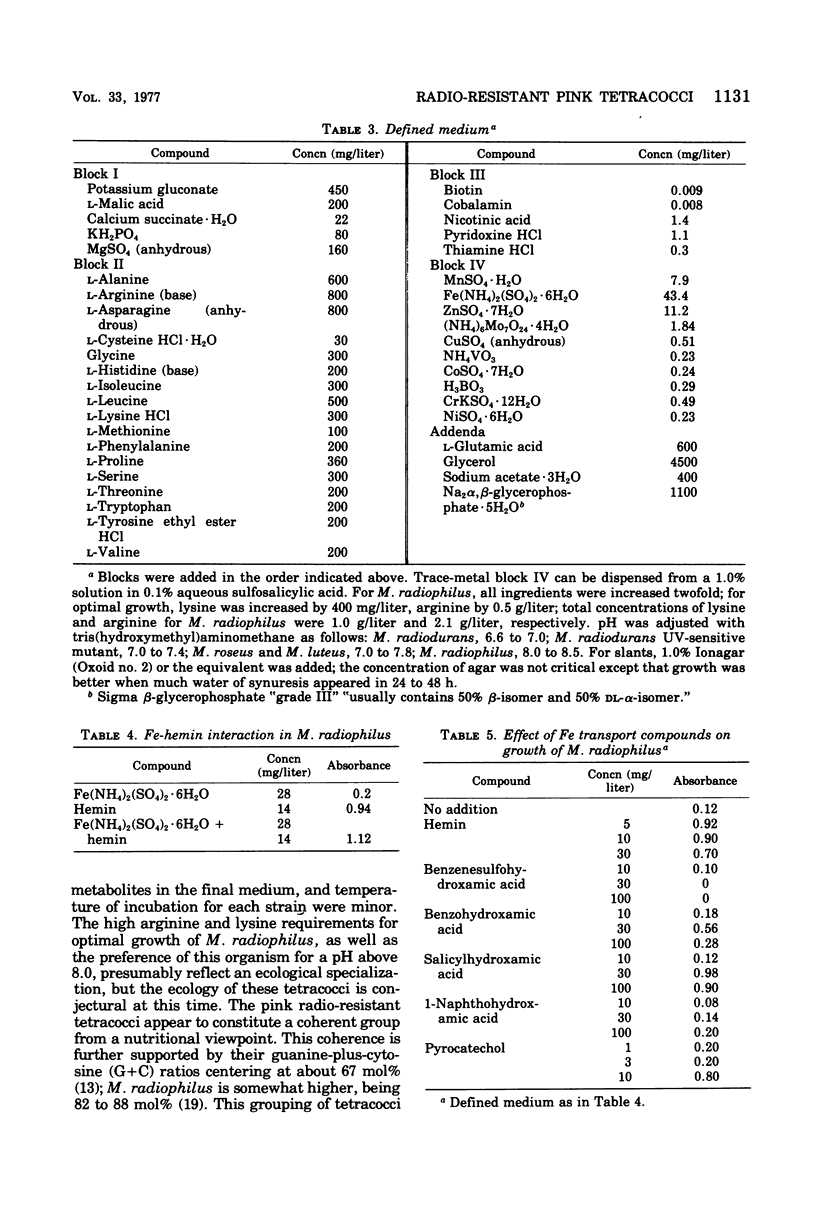
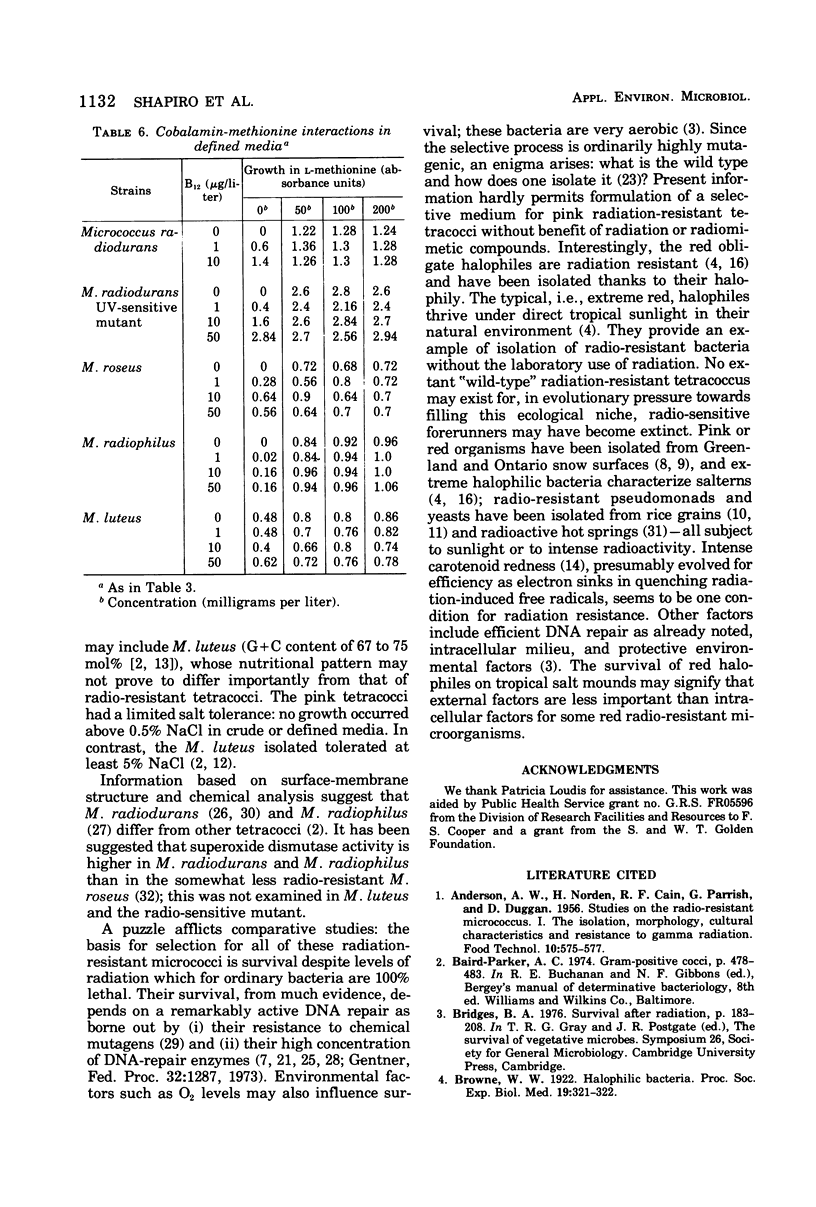
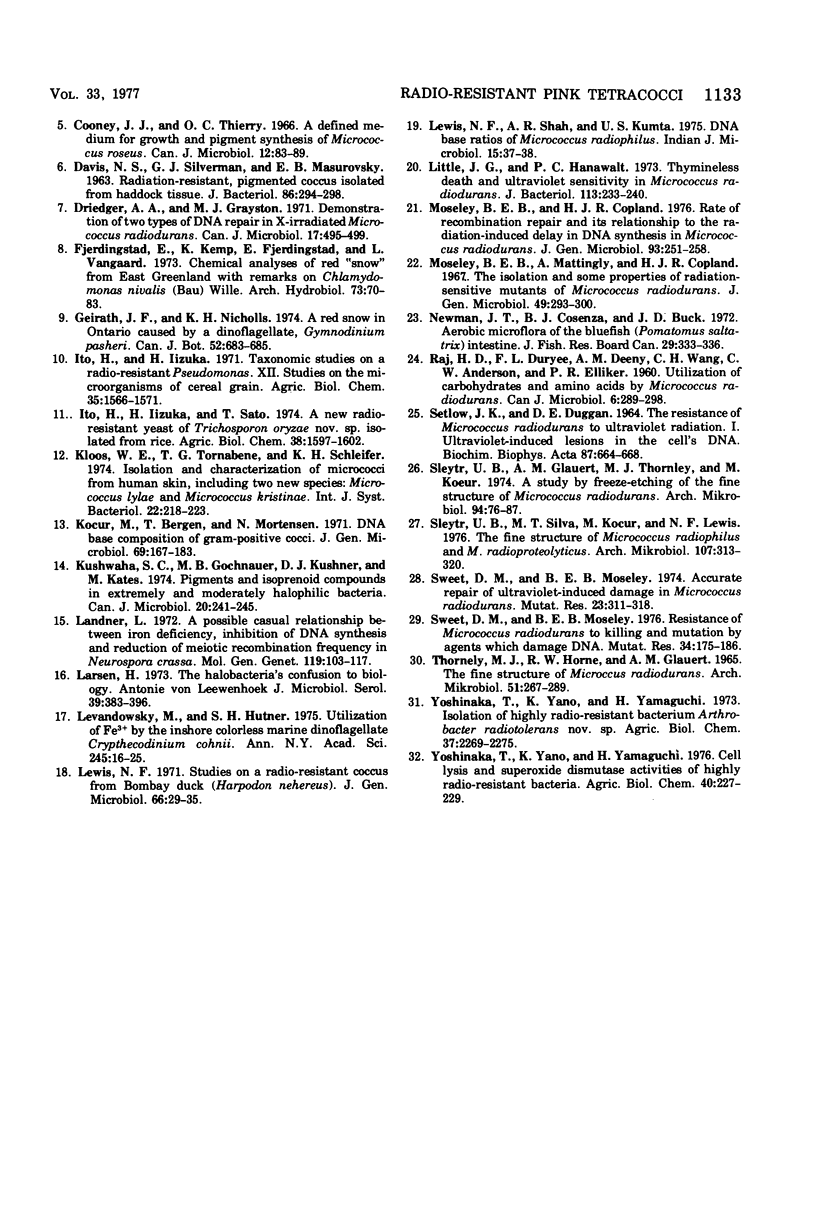
Selected References
These references are in PubMed. This may not be the complete list of references from this article.
- Cooney J. J., Thierry O. C. A defined medium for growth and pigment synthesis of Micrococcus roseus. Can J Microbiol. 1966 Feb;12(1):83–89. doi: 10.1139/m66-012. [DOI] [PubMed] [Google Scholar]
- DAVIS N. S., SILVERMAN G. J., MASUROVSKY E. B. RADIATION-RESISTANT, PIGMENTED COCCUS ISOLATED FROM HADDOCK TISSUE. J Bacteriol. 1963 Aug;86:294–298. doi: 10.1128/jb.86.2.294-298.1963. [DOI] [PMC free article] [PubMed] [Google Scholar]
- Driedger A. A., Grayston M. J. Demonstration of two types of DNA repair in X-irradiated Micrococcus radiodurans. Can J Microbiol. 1971 Apr;17(4):495–499. doi: 10.1139/m71-082. [DOI] [PubMed] [Google Scholar]
- Kocur M., Bergan T., Mortensen N. DNA base composition of Gram-positive cocci. J Gen Microbiol. 1971 Dec;69(2):167–183. doi: 10.1099/00221287-69-2-167. [DOI] [PubMed] [Google Scholar]
- Kushwaha S. C., Gochnauer M. B., Kushner D. J., Kates M. Pigments and isoprenoid compounds in extremely and moderately halophilic bacteria. Can J Microbiol. 1974 Feb;20(2):241–245. doi: 10.1139/m74-038. [DOI] [PubMed] [Google Scholar]
- Landner L. A possible causal relationship between iron deficiency, inhibition of DNA synthesis and reduction of meiotic recombination frequency in Neurospora crassa. Mol Gen Genet. 1972;119(2):103–117. doi: 10.1007/BF00269130. [DOI] [PubMed] [Google Scholar]
- Larsen H. The fourth A. J. Kluyver memorial lecture delivered before the Netherlands Society for Microbiology on April 27th, 1972, at the Delft University of Technology, Delft. The halobacteria's confusion to biology. Antonie Van Leeuwenhoek. 1973;39(3):383–396. doi: 10.1007/BF02578880. [DOI] [PubMed] [Google Scholar]
- Levandowsky M., Hutner S. H. Utilization of Fe3+ by the inshore colorless marine dinoflagellate Crypthecodinium cohnii. Ann N Y Acad Sci. 1975 Jan 24;245:16–25. doi: 10.1111/j.1749-6632.1975.tb26828.x. [DOI] [PubMed] [Google Scholar]
- Lewis N. F. Studies on a radio-resistant coccus isolated from Bombay duck (Harpodon nehereus). J Gen Microbiol. 1971 Apr;66(1):29–35. doi: 10.1099/00221287-66-1-29. [DOI] [PubMed] [Google Scholar]
- Little J. G., Hanawalt P. C. Thymineless death and ultraviolet sensitivity in Micrococcus radiodurans. J Bacteriol. 1973 Jan;113(1):233–240. doi: 10.1128/jb.113.1.233-240.1973. [DOI] [PMC free article] [PubMed] [Google Scholar]
- Moseley B. E., Copland H. J. The rate of recombination repair and its relationship to the radiation-induced delay in DNA synthesis in Micrococcus radiodurans. J Gen Microbiol. 1976 Apr;93(2):251–258. doi: 10.1099/00221287-93-2-251. [DOI] [PubMed] [Google Scholar]
- RAJ H. D., DURYEE F. L., DEENEY A. M., WANG C. H., ANDERSON A. W., ELLIKER P. R. Utilization of carbohydrates and amino acids by Micrococcus radiodurans. Can J Microbiol. 1960 Jun;6:289–298. doi: 10.1139/m60-033. [DOI] [PubMed] [Google Scholar]
- SETLOW J. K., DUGGAN D. E. THE RESISTANCE OF MICROCOCCUS RADIODURANS TO ULTRAVIOLET RADIATION. I. ULTRAVIOLET-INDUCED LESIONS IN THE CELL'S DNA. Biochim Biophys Acta. 1964 Aug 12;87:664–668. doi: 10.1016/0926-6550(64)90284-1. [DOI] [PubMed] [Google Scholar]
- Sleytr U. B., Kocur M., Glauert A. M., Thornley M. J. A study by freeze-etching of the fine structure of Micrococcus radiodurans. Arch Mikrobiol. 1973 Dec 4;94(1):77–87. doi: 10.1007/BF00414079. [DOI] [PubMed] [Google Scholar]
- Sleytr U. B., Silva M. T., Kocur M., Lewis N. F. The fine structure of Micrococcus radiophilus and Micrococcus radioproteolyticus. Arch Microbiol. 1976 Apr 1;107(3):313–320. doi: 10.1007/BF00425346. [DOI] [PubMed] [Google Scholar]
- Sweet D. M., Moseley B. E. Accurate repair of ultraviolet-induced damage in Micrococcus radiodurans. Mutat Res. 1974 Jun;23(3):311–318. doi: 10.1016/0027-5107(74)90104-3. [DOI] [PubMed] [Google Scholar]
- Sweet D. M., Moseley B. E. The resistance of Micrococcus radiodurans to killing and mutation by agents which damage DNA. Mutat Res. 1976 Feb;34(2):175–186. doi: 10.1016/0027-5107(76)90122-6. [DOI] [PubMed] [Google Scholar]
- Thornley M. J., Horne R. W., Glauert A. M. The fine structure of Micrococcus radiodurans. Arch Mikrobiol. 1965 Jul 20;51(3):267–289. doi: 10.1007/BF00408143. [DOI] [PubMed] [Google Scholar]


